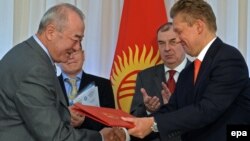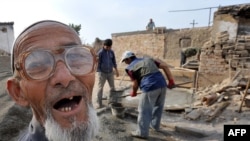
As the European Union scrambles to convince Russia and Ukraine to strike a deal that ensures supplies of Russian natural gas reach EU consumers, a different set of gas negotiations have started in Central Asia.
On June 10, Russia's Gazprom, which is now the owner of Kyrgyzgaz, sent representatives to Uzbekistan to negotiate a price for gas supplies to Kyrgyzstan. As confusing as that might sound, these talks are likely to get much weirder.
First, a little background information might be helpful. In 1990, the then Soviet republic of Kirghizia used more than 2 billion cubic meters of gas. Since 2000, gas consumption has remained at about 700 million cubic meters or slightly lower. Kyrgyzstan does not have much domestic gas. Last year it produced 21.52 million cubic meters, roughly the average production figure for many years.
Most of you know that Gazprom recently completed an agreement to purchase Kyrgyzstan's state gas company Kyrgyzgaz for a symbolic $1. Russia wrote off a huge part of Kyrgyzstan's debt in return and Gazprom has pledged to invest some $570 million in repairing and modernizing Kyrgyzstan's aging gas infrastructure, pipelines and all. Most importantly, Kyrgyzstan's chronic problems with gas imports from neighboring Uzbekistan, which supplies Kyrgyzstan with some 98% of its gas, are supposed to soon be no more than a memory.
Despite some recent financial setbacks, Gazprom remains a formidable company, which some believe functions as a wing of the Russian Foreign Ministry. Gazprom should have some leverage at the bargaining table with Uzbekistan that officials from Kyrgyzgaz would previously never have had.
The Russian company's potentially greater clout includes an agreement to develop two gas fields in Uzbekistan and this is where the first possible problem emerges.
When the Russian State Duma ratified the deal for Gazprom to take over Kyrgyzgaz on January 17 this year, deputy Energy Minister Anatoly Yanovsky told lawmakers, "It's planned that gas will come from the territory of Uzbekistan [to Kyrgyzstan], but from those areas, which are currently being developed on the territory of this country [Uzbekistan] by Gazprom."
'Two's company...'
So, Gazprom's operation in Uzbekistan is going to sell Uzbek gas to a Gazprom subsidiary in Kyrgyzstan. And Yanovsky said the price would be cheaper than the price Uzbekistan was charging Kyrgyzstan. Supplies are suspended at the moment but when gas was coming it cost $290 per 1,000 cubic meters.
For Uzbekistan this all seems like a bad deal. Its gas is about to be sold to its former customer for a lower price.
But, the fields Gazprom is working in Uzbekistan – the Shakhpakhty and the Ustyurt Plateau structure – are in the far western part of Uzbekistan near the Aral Sea.
The fields are part of Central Asian gas supplies feeding, or intended to feed, the Soviet-era Central Asia-Tsentr pipeline that runs northwest to Russia.
Thus Gazprom might own some Uzbek gas, but it cannot get the gas to its destination in Kyrgyzstan without help from Uztransgaz, the subsidiary of Uzbekneftegaz, in charge of transporting gas and liquid hydrocarbons produced in Uzbekistan to domestic consumers and for export.
Trying to ship the gas across southern Kazakhstan is not an option since there is no existing pipeline network for such exports and, in any case, the gas would arrive in northern Kyrgyzstan, not southern Kyrgyzstan where it is more desperately needed. Construction of a new pipeline across the mountains that divide northern and southern Kyrgyzstan would be costly and take years.
So, negotiations have started and it remains unclear who between Gazprom and Uzbekistan has the advantage at the bargaining table.
For the people of Kyrgyzstan, particularly the people of southern Kyrgyzstan, who have grown accustomed to regular power and heating shortages, having Gazprom on their side in talks with Uzbekistan might inspire confidence that times are changing.
But, with the addition of Gazprom to the negotiations, only a complicated formula will make possible the dream of uninterrupted and cheaper supplies of Uzbek gas to Kyrgyzstan.
And I can't help thinking about that saying: "Two's company, three's a crowd."
-- Bruce Pannier, with contributions from the director of RFE/RL's Kyrgyz Service, Venera Djumataeva, and RFE/RL's Uzbek Service director Alisher Sidikov
ANNOUNCEMENT: Congratulations to my colleague at RFE/RL's Tajik Service, Saidkosim Djalolov, who has authored two new books just published – " Гар тахаммул пеша дори, одами" ("A Tolerant Man and Truths"), about religion and tolerance and " Нардбон" ("Ladder") a collection of humorous short stories.
On June 10, Russia's Gazprom, which is now the owner of Kyrgyzgaz, sent representatives to Uzbekistan to negotiate a price for gas supplies to Kyrgyzstan. As confusing as that might sound, these talks are likely to get much weirder.
First, a little background information might be helpful. In 1990, the then Soviet republic of Kirghizia used more than 2 billion cubic meters of gas. Since 2000, gas consumption has remained at about 700 million cubic meters or slightly lower. Kyrgyzstan does not have much domestic gas. Last year it produced 21.52 million cubic meters, roughly the average production figure for many years.
Most of you know that Gazprom recently completed an agreement to purchase Kyrgyzstan's state gas company Kyrgyzgaz for a symbolic $1. Russia wrote off a huge part of Kyrgyzstan's debt in return and Gazprom has pledged to invest some $570 million in repairing and modernizing Kyrgyzstan's aging gas infrastructure, pipelines and all. Most importantly, Kyrgyzstan's chronic problems with gas imports from neighboring Uzbekistan, which supplies Kyrgyzstan with some 98% of its gas, are supposed to soon be no more than a memory.
Despite some recent financial setbacks, Gazprom remains a formidable company, which some believe functions as a wing of the Russian Foreign Ministry. Gazprom should have some leverage at the bargaining table with Uzbekistan that officials from Kyrgyzgaz would previously never have had.
The Russian company's potentially greater clout includes an agreement to develop two gas fields in Uzbekistan and this is where the first possible problem emerges.
When the Russian State Duma ratified the deal for Gazprom to take over Kyrgyzgaz on January 17 this year, deputy Energy Minister Anatoly Yanovsky told lawmakers, "It's planned that gas will come from the territory of Uzbekistan [to Kyrgyzstan], but from those areas, which are currently being developed on the territory of this country [Uzbekistan] by Gazprom."
'Two's company...'
So, Gazprom's operation in Uzbekistan is going to sell Uzbek gas to a Gazprom subsidiary in Kyrgyzstan. And Yanovsky said the price would be cheaper than the price Uzbekistan was charging Kyrgyzstan. Supplies are suspended at the moment but when gas was coming it cost $290 per 1,000 cubic meters.
For Uzbekistan this all seems like a bad deal. Its gas is about to be sold to its former customer for a lower price.
But, the fields Gazprom is working in Uzbekistan – the Shakhpakhty and the Ustyurt Plateau structure – are in the far western part of Uzbekistan near the Aral Sea.
The fields are part of Central Asian gas supplies feeding, or intended to feed, the Soviet-era Central Asia-Tsentr pipeline that runs northwest to Russia.
Thus Gazprom might own some Uzbek gas, but it cannot get the gas to its destination in Kyrgyzstan without help from Uztransgaz, the subsidiary of Uzbekneftegaz, in charge of transporting gas and liquid hydrocarbons produced in Uzbekistan to domestic consumers and for export.
Trying to ship the gas across southern Kazakhstan is not an option since there is no existing pipeline network for such exports and, in any case, the gas would arrive in northern Kyrgyzstan, not southern Kyrgyzstan where it is more desperately needed. Construction of a new pipeline across the mountains that divide northern and southern Kyrgyzstan would be costly and take years.
So, negotiations have started and it remains unclear who between Gazprom and Uzbekistan has the advantage at the bargaining table.
For the people of Kyrgyzstan, particularly the people of southern Kyrgyzstan, who have grown accustomed to regular power and heating shortages, having Gazprom on their side in talks with Uzbekistan might inspire confidence that times are changing.
But, with the addition of Gazprom to the negotiations, only a complicated formula will make possible the dream of uninterrupted and cheaper supplies of Uzbek gas to Kyrgyzstan.
And I can't help thinking about that saying: "Two's company, three's a crowd."
-- Bruce Pannier, with contributions from the director of RFE/RL's Kyrgyz Service, Venera Djumataeva, and RFE/RL's Uzbek Service director Alisher Sidikov
ANNOUNCEMENT: Congratulations to my colleague at RFE/RL's Tajik Service, Saidkosim Djalolov, who has authored two new books just published – " Гар тахаммул пеша дори, одами" ("A Tolerant Man and Truths"), about religion and tolerance and " Нардбон" ("Ladder") a collection of humorous short stories.






